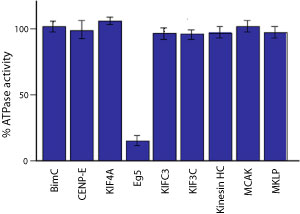HTS kinesin ATPase Endpoint Assay Biochem Kit (BK053)
Product Uses Include
- Measuring microtubule-activated kinesin ATPase activity
- Discovering/characterizing kinesin inhibitors
- Discovering/characterizing kinesin regulating cofactors
Introduction
Eukaryotic kinesin motor proteins orchestrate a wide range of kinetic events within a cell. They have been shown to move cargo, such as chromosomes and vesicles, along microtubule tracks (1). They also play a major role in the organization of cytoskeletal architecture as evidenced in the establishment of the microtubule spindle during mitosis (2).
Kinesins operate by utilizing the energy of ATP hydrolysis to move along their microtubule (MT) substrates. Once a kinesin motor binds to its MT track, the ATPase rate of the motor is often enhanced several hundred to several thousand-fold (3). MT activated kinesin ATPase is a major parameter in motor function and serves as a powerful method to monitor and study kinesin activity under various experimental conditions.
As part of its Cytoskeleton Motor Werks (CMW) line of research reagents, Cytoskeleton, Inc. has developed the Kinesin ATPase End-Point Biochem Kit™ (BK053). The kinesin end-point assay is an extremely quick and economical way to measure inorganic phosphate (Pi) generated during the microtubule activated ATPase activity of kinesin motor proteins. Large numbers of assays can be performed simultaneously in a homogenous reaction, making the assay highly suitable for HTS applications. The assay is based upon a colorimetric change, measured at 650 nm.
More detailed kinetic studies for kinesin MT activated ATPase assays can be performed with Biochem Kit™ BK060. Cytoskeleton, Inc. also offers a wide range of kinesin motors (see the Cytoskeleton Motor Werks page).
Kit contents
The kit contains sufficient materials for 1000 assays. The following components are included:
- CytoPhos™ reagent
- Kinesin motor protein (Cat. # KR01)
- Pre-formed microtubules (Cat. # MT002)
- Kinesin Reaction Buffer
- Paclitaxel (Cat. # TXD01)
- Phosphate standard
- DMSO
- Manual with detailed protocols and extensive troubleshooting guide
Equipment needed
- Spectrophotometer capable of measuring absorbance at 650 nm wavelength.
- Small capacity (100-1000 µl) cuvettes or 96-well microtiter plates.
Example results
The activity of the Eg5-specific inhibitor, monastrol, was tested on 9 different kinesin motor domains (see the CMW page). Of the assayed motor domains, only the ATPase activity of Eg5 was inhibited. (Fig 1)

Figure 1. Inhibition of kinesin activity with the Eg5 specific inhibitor monastrol. The results show percent of full kinesin activity in the presence of 100 µM monastrol. As expected, only Eg5 ATPase activity is inhibited by monastrol.
References
- Goldstein, L. (1993) Annu. Rev. Genet. 27, 319-351
- Sawin, K. E. and Scholey, J. M. (1991) Trends Cell Biol. 1, 122-129
- Kuznetsov, S. A., and Gelfand, V. I. (1986) Proc. Natl. Acad. Sci. USA 83, 8530-8534
For product Datasheets and MSDSs please click on the PDF links below. For additional information, click on the FAQs tab above or contact our Technical Support department at tservice@cytoskeleton.com
Question 1: What is the detection range of the Kinesin ATPase End-Point Biochem Kit (Cat. # BK053)?
Answer 1: The reaction can detect phosphate over a range of 1 μM – 50 μM Pi (equivalent to 0.1 nmoles – 5.0 nmoles Pi in 100 μl reaction volume).
Question 2: Is the Kinesin ATPase End-Point Biochem Kit (Cat. # BK053) compatible with other kinesins sold by Cytoskeleton or only the human kinesin heavy chain protein included with the kit?
Answer 2: Yes, the Kinesin ATPase End-Point Biochem Kit (Cat. # BK053) can be used with any of the other kinesin motor proteins sold by Cytoskeleton, Inc. Please see the protein’s datasheet on our website (www.cytoskeleton.com) for representative data detailing each motor protein’s ATPase activity using either this kit (Cat. # BK053) or our Kinesin ELIPA Biochem Kit (Cat. # BK060).
If you have any questions concerning this product, please contact our Technical Service department at tservice@cytoskeleton.com











